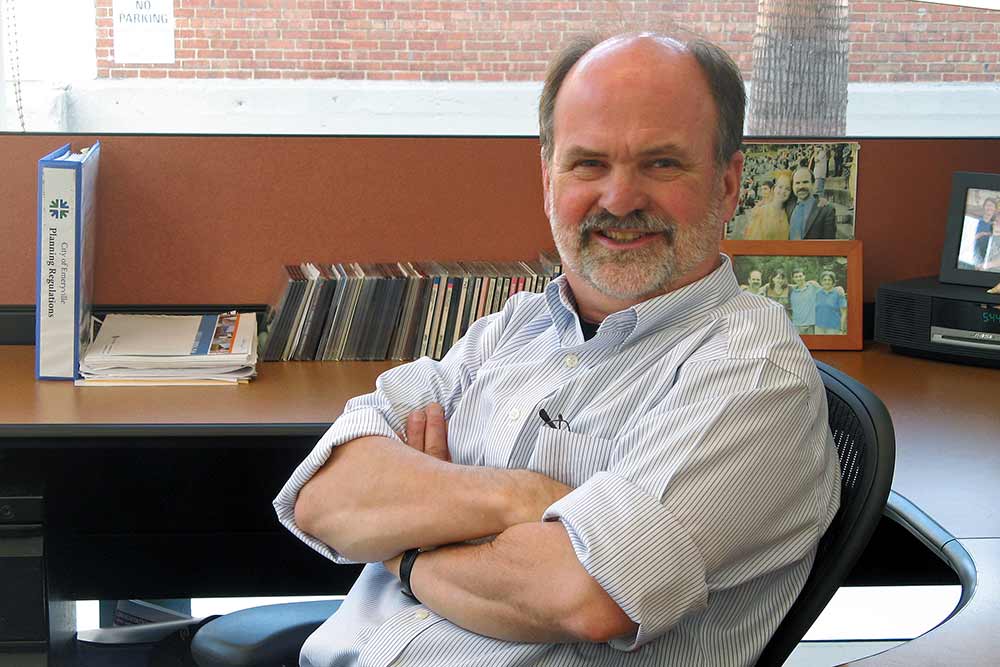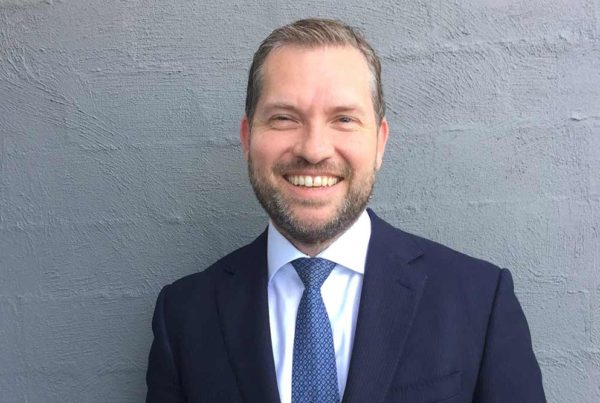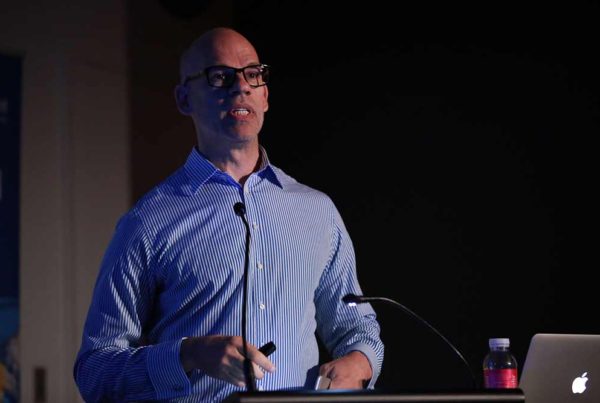
Image: City of Emeryville’s Community Development Director, Charles Bryant
Charles S. Bryant, AICP, is the Community Development Director for the City of Emeryville, California, overseeing long-range planning, current planning, environmental review, the building permit process, and the City’s economic development, affordable housing, public art, brownfields and grants management programs. During his 16-year tenure with Emeryville, its population has almost doubled and several thousand new housing units and over a million square feet of commercial space have been approved or completed.
Before coming to Emeryville, Mr Bryant worked as a planner for the City of Oakland for 18 years. He started as an Intern while still in graduate school, and had various roles there, including three years as the City’s first Environmental Review Coordinator, three years overseeing long-range planning projects including the General Plan Update, and five years as Planning Commission Secretary and supervisor of Commission cases.
Here we interview Mr Bryant with a deep focus on the process of transforming a significant portion of the local government area from an industrial ‘wasteland’ to a new thriving economy.
Australian public sector readers are fascinated by the transformation of Emeryville’s biotech precinct, especially since local areas in Sydney are going through similar changes – what features and changes are you most proud of in the city?
I am most proud the improvements in quality of life that have been achieved for the Emeryville community. This includes parks, bike paths, recreational programs, early childhood learning facilities, and, most recently, the opening of the Emeryville Center of Community Life. ECCL is a joint city-school facility that houses all grades of the Emery Unified School District, the City’s Community Services Department with recreation and senior citizen programs, and a wellness center, library, gymnasium, and swimming pool for the community. This facility is the first of its kind in California, and it required overcoming many challenges, including an amendment to a state law that previously prohibited cities and school districts from sharing the same buildings.
What was the background of the biotech precinct’s transformation? How did the area function before, and what have been the fundamental changes that make it different today?
First, we don’t refer to a “biotech precinct”. Emeryville is a very small city, only about 1.2 square miles (that’s about 3 square kilometers), and is a mixed-use community with many different vibrant activities. Biotech is one of them. Our largest employers include Pixar Animation Studios (creators of “Finding Nemo”, which takes place in Sydney); AC Transit (our local public transit agency); Oaks Card Club (a vestige of Emeryville’s past as a gambling hub); IKEA (we had the first in Northern California); Clif Bar (manufacturers of energy bars that are very big in the US); Leapfrog (manufacturer of educational toys and games); Peet’s Coffee and Tea (main rival of Starbucks in the US); American Automobile Association of Northern California, Nevada, and Utah; and the biotech companies Novartis, Grifols Diagnostic Solutions, and Amyris, among many others.
Previously part of a vast Spanish/Mexican cattle ranch, Emeryville was incorporated as a city in 1896. At the time, it had a horse racing track, a steel mill, a paint factory, and many stockyards and slaughter houses. A transcontinental railroad mainline, built in the 1870s, ran through the town and spurred industrial development. Later, construction of the Bay Bridge between Oakland and San Francisco, and Interstate 80, the main highway between the West Coast and New York City, provided further impetus for growth. Throughout the first seven decades of the twentieth century, Emeryville thrived as an industrial hub, with the factories, warehouses, and headquarters offices of many large corporations. During this period, only about 2,500 people lived in the city, and railroad spurs ran down almost every street.
By the 1960s, industries in older inner cities such as Emeryville, with increasingly outdated facilities, were beginning to move away to outlying areas where land was plentiful and cheap. In 1966, the City adopted its first “General Plan” to guide its future growth and development, and in 1975 it established a “Redevelopment Agency”. Redevelopment was a tool under California State law that allowed cities to utilize “Tax Increment Financing” (or TIF) whereby the increases in property tax that resulted from new development were used to pay for infrastructure improvements and to help catalyze further growth.
The strategic use of the Redevelopment tool by the City led to a complete make-over of the community and a huge increase in both population and employment. Millions of dollars in TIF funding were used to clean up contaminated sites (the vestiges of the previous industrial operations) and to assemble sites for redevelopment. The City actively sought qualified developers and worked with them to create office, retail, and residential projects. TIF funding was also the main financing mechanism for the City’s ambitious Capital Improvement Program, including upgraded sewer lines, street beautification projects, and amenities such as parks, bike paths, and community facilities.
As a result, there are now about 12,000 residents and 20,000 jobs in our 1.2 square miles. The city has approximately 7,500 dwelling units, 1 million square feet of retail space, and 4 million square feet of office/laboratory space. What was once a gritty industrial backwater has been transformed into a vibrant mixed-use urban center.
What was your role in the redevelopment of the biotech precinct and how it was planned and implemented?
I have been with the City of Emeryville for 16 years, and much of the “heavy lifting” for Emeryville’s renaissance happened before I got here. When I was hired as Emeryville’s new Planning and Building Director in 2000, the transformation was well underway, and the community’s attention was shifting from wholesale redevelopment activities to a more nuanced focus on ways to improve and enhance the quality of life, while still fostering continued growth. Sensing this shift in direction, I led the effort to update the City’s General Plan, which had last been revised in 1988.
The General Plan Update project began in 2004 and was guided by a 16-member Steering Committee with representatives from the City Council, Planning Commission, School District, businesses, and residents. The process involved over 50 public Steering Committee meetings including bus tours and panel discussions; stakeholder interviews, mail-in surveys, and newsletters; 16 reports on all aspects of technical analysis and public outreach; and seven community workshops. Ultimately, consensus was achieved and the plan was adopted in 2009, after five years of intensive work by the community. Its approval by the Steering Committee, Planning Commission, and City Council was virtually unanimous (there was one dissenting vote on the Council).
“Big ideas” incorporated in the General Plan included preservation and enhancement of existing residential neighborhoods; preservation and enhancement of the existing industrial enclave; a high-density, high-rise core in the center of the city, stepping down in all directions; “bonus” height, density, and intensity based on a point system for providing community benefits; four neighborhood centers to serve the local needs of the community; a regional retail shopping district; transit oriented development at the railroad station and regional bus hub; redevelopment of older shopping centers into high-density urban neighborhoods; a transportation system based on alternative modes of travel to the car; new community parks and greenways; pedestrian amenities; and sustainable development.
The plan was honored with an award from the American Planning Association, the professional organization of city planners in the United States. But even more gratifying to me is the way the community has taken ownership of the plan. They will often hold it up at public meetings arguing for or against a proposed project in light of how well it conforms to “our General Plan”.
In the seven years since the General Plan was adopted, growth has continued, now guided by this new vision. Three years ago we adopted new Planning Regulations, a complete overhaul of our old Zoning Ordinance, which implement the goals and policies of the General Plan in great detail. Recently, we adopted “Family Friendly Design Guidelines” to foster high density residential development that meets the needs of families with children.
We currently have about 2,000 new residential units and 250,000 square feet of commercial space under development, including a new hotel, office and retail space, and a high-rise biotech lab building and transit center at our railroad station. All of this development is consistent with the community’s vision developed as part of the General Plan Update process.
What were the biggest challenges or impedances that the City of Emeryville faced while the biotech revitalisation was taking place? How did you overcome these challenges?
Undoubtedly, the biggest challenge in Emeryville’s rebirth was the contamination left behind by the city’s heritage as an industrial Mecca. Partnering with the U.S. Environmental Protection Agency, the California Department of Toxic Substances Control, and other regulatory agencies, the Emeryville Redevelopment Agency spent millions of dollars on the remediation of these “brownfields”.
The Agency also took advantage of a State law that allowed them to go after the original polluters to pay some of the costs of the cleanup. As a result, most development sites in Emeryville are now clean, although some still have “institutional controls” in place to prevent future residents from coming into contact with the residual contamination that inevitably remains.
Today, we face different, and in many ways more intractable, socio-economic challenges in the form of low wages and high housing costs. Emeryville has had an affordable housing program for almost 25 years, as a result of which about 12% of our housing stock are controlled as “below market rate” (BMR) units. Recently, the program has been beefed up to require as much as 17% affordable units in rental projects, and up to 25% in condominium developments.
The City has also undertaken to build 100% affordable projects, including a recently completed 69-unit project and an 87-unit project soon to be under construction. But this only begins to scratch the surface of the affordable housing and homelessness crisis that plagues Emeryville and the San Francisco Bay Area. Recently, a 101-unit project was completed and over 2,300 applications were received for its 12 affordable units, almost 200 applications per unit! To address this crisis, four Bay Area counties are holding referenda as part of the upcoming November elections on bond measures to fund an unprecedented number of new affordable units.
A related and equally challenging problem is the growing income disparity among our citizens. Many Emeryville retail and service workers at the low end of the wage scale do not make enough to be able to afford to live in the city. This means they must travel long distances between their homes and their jobs, which adds to traffic congestion, air pollution, and energy consumption.
The federal and state governments have been reluctant to make meaningful increases in the minimum wage, so many cities, including Emeryville, have taken matters into their own hands. As a result, last year Emeryville passed what is, for now, the highest minimum wage in the United States, at $13/hour for small businesses, and $14.82/hour for large businesses. These rates will increase and converge at approximately $16/hour in 2019.
Remediation of contaminated sites is a localized problem with an expensive, but relatively simple, solution: dig up the dirty dirt, haul it away, and replace it with clean dirt. Solving the affordable housing and income crises are much more difficult and will take a concerted effort on the part of society at large; although we are doing the best that we can to address these issues at the local level, it is far beyond the ability of a small city like Emeryville to solve these socio-economic crises by itself.
What steps did the city need to take in financing the project?
As previously noted, the major tool of Redevelopment was Tax Increment Financing (TIF). Under this mechanism, a “baseline” property tax was set when a Redevelopment Area was established. In California, property tax is generally divided among a number of “taxing entities”, including the City, County, School District, transit agencies, and a variety of special districts. The “baseline” tax continued to be divided among these taxing entities.
However, as new development occurred within a Redevelopment Area and the value of the property increased, the incremental increase in property tax, or the “tax increment”, went entirely to the Redevelopment Agency. Since almost the entire City of Emeryville was in a Redevelopment Area, the Redevelopment Agency collected millions of dollars in tax increment. This was used to acquire and assemble development sites, remediate contaminated soil and ground water, catalyze development, and build capital improvement projects.
In 2012, for a variety of political and economic reasons, the State of California abolished Redevelopment. Cities were allowed to complete projects that they had started, called “enforceable obligations”, but they could not start new projects and there was no more tax increment revenue.
There was much disagreement between the State and former Redevelopment Agencies about what constituted an “enforceable obligation”, which led to many lawsuits. Emeryville was a leader in suing the State, and won back many millions of dollars for projects that otherwise could never be built, including a new pedestrian/bicycle bridge over the railroad and the Emeryville Center of Community Life.
Without Redevelopment, the City has had to get creative about financing future projects to enhance the quality of life for our community. Recently, we became a “charter city”, which allowed us to greatly increase our real estate transfer tax. We also have created “development impact fees” on building permits to fund parks and recreation facilities, transportation facilities, and affordable housing.
In addition, the City now aggressively pursues grant opportunities from the state and federal governments and private institutions, something we never had to do during the days of Redevelopment. Life is very different without Redevelopment, but we have learned to adapt and things continue to get done.
Now that the revitalisation is completed, what economic advantages has that given to Emeryville?
Revitalization is never complete. The transformation of Emeryville from a gritty industrial town to a vibrant mixed-use urban center is mostly accomplished, and now the focus is on enhanced quality of life for the community.
The robust commercial environment that now exists in Emeryville has fostered a diverse tax base that helps to ensure that the City can ride out any future downturns in the economy. It has also given the City sufficient revenues, in spite of the demise of Redevelopment, to continue to pursue capital improvement projects and services for our community.
How do you feel about the interest that the transformation has generated internationally through the initiation of exchange programs and analysis from the Future Cities Collaborative?
It is gratifying to know that a tiny city like Emeryville can spark international interest in our story of reinvention. It reminds me of the time a few years ago when Emeryville beat out Los Angeles as one of the finalists for the permanent home of the California Institute for Regenerative Medicine, the State’s stem cell research institution. When he heard the news, the mayor of Los Angeles reportedly exclaimed “Emeryville? Where the hell is Emeryville?” That pretty well sums it up.
If another council, whether in the United States, Australia or anywhere else, is interested in doing its own revitalisation of an area that needs a facelift and a new economic lease on life, what advice would you offer?
Don’t pursue a “one size fits all” solution. What’s right for Emeryville might not be right for you. Develop strategies tailored to the unique circumstances of your situation. Do an honest assessment of your strengths and weaknesses, your opportunities and challenges. Then build on your strengths, tackle your weaknesses, take advantage of opportunities, and rise to the challenges. Engage your community in an open and candid visioning exercise.
Make sure that all interest groups have a voice in the process and a place at the table. Strive for consensus and acknowledge dissenting views. Foster “buy-in” in the resulting plan by all key stakeholders, including residents, businesses, and other interest groups. Once the vision is established, be clear and consistent in its implementation. Don’t be afraid to dream big, despite what your critics may say. Strive for the impossible and you might just find that you can achieve the improbable.
For more information on the City of Emeryville’s transformation from an Australian perspective, read our in-depth interview with Woollahra City Council’s Katherine O’Regan, who is also a leading figure in the Future Cities Collaborative.
View more from Shaping The Future series See video series and sign up




